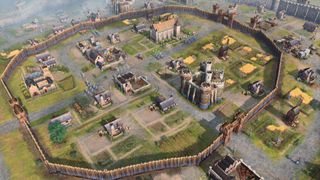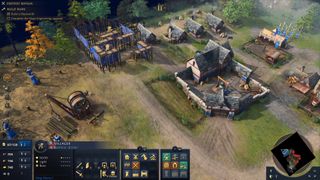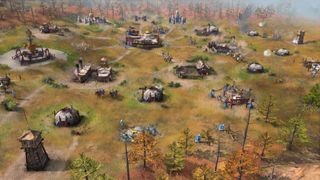Which is the best Age of Empires IV civilization for beginners?
Age of Empires IV recommends two civilizations in particular to new players

Age of Empires IV has been out for a few weeks, and the game is already a hit. With great reviews, plenty of copies sold and tens of thousands of concurrent players on Steam, the latest entry in Microsoft’s long-running strategy series is off to a strong start. The game is also available on Xbox Game Pass, so if you haven’t tried it out yet, it’s high time to do so.
The only problem is that Age of Empires IV is a deep, complex game with a lot of different systems to master. If you’ve played the series before, you can probably dive right in and pick up the basics as you go. But if this is your first historical real-time strategy game, even the early stages in AoE 4 can feel daunting. How many resources do you need? How should you build your army? When should you attack the enemy, and when should you defend your own territory?
The game (and your own intuition) will answer these questions as you progress. But picking the right civilization will help you reach the answers much faster. While every civilization in AoE 4 has strengths and weaknesses, some are more difficult to play than others. Starting off with a highly technical civilization is a recipe for frustration and confusion rather than mastery.
Luckily, unlike previous games, AoE 4 comes right out and tells you which civilizations are best-suited to newcomers. Read on to learn which Age of Empires IV civilizations are best for beginners, and how to make the most of your time with them.
The English

First off, if you’re new to the series and want to start with an earlier game, feel free to check out my beginner civilization guides for Age of Empires II and Age of Empires III. (I didn’t write one for the original Age of Empires, but I would go with either the Egyptians or the Sumerians.)
If you want to play Age of Empires IV, though, rest assured that it’s an excellent starting point for the series. The game features difficulty options to suit every skill level, as well as an approachable and educational campaign that makes it easy to understand the broad strokes of world history. One particularly helpful new feature is that the developers have assigned each civilization a difficulty level, ranging from one star (easiest) to three stars (hardest).
The English are one of two one-star civilizations in the game. If you play the campaign, the English are also the first civilization you’ll encounter. While the English aren’t better or worse than any other civilization in the game, they are quite a bit more straightforward to play. You create villagers, who build dedicated drop points to gather resources. You use those resources to field a balanced army of infantry, cavalry and archers. To defend your town, you can build mighty stone walls and foreboding castles. It’s classic AoE gameplay, from top to bottom.
Sign up to get the BEST of Tom’s Guide direct to your inbox.
Upgrade your life with a daily dose of the biggest tech news, lifestyle hacks and our curated analysis. Be the first to know about cutting-edge gadgets and the hottest deals.
Furthermore, the English have significant early-game advantages, in both economics and warfare. Farms cost 50% less wood, and a nearby mill will boost gather rates by 15%. English military units fight better within range of town centers, outposts, towers and keeps, which means that early English settlements are relatively difficult to invade. Finally, the English can build Men-at-Arms in the Dark Age, giving them access to a powerful melee unit much earlier than other civilizations.
The English also have access to a unique unit: the longbowman. Longbowmen don’t cost much to build, but feature excellent attack power and range. A company of longbowmen behind a wall can make short work of invaders. Alternatively, if you position your longbowmen behind attacking infantry or cavalry, you can pick off a lot of enemy units as they struggle to advance.
The French

The other one-star civilization in Age of Empires IV is the French. To be fair, the French are a bit tougher to play than the English, focusing more on late-game dominance than early-game survival. But the basic setup is still the same: Create villagers, build dedicated resource drops, and slowly expand your territory while you grow your economy and army.
The French can actually get off to a quicker start than the English, since villagers take 10% less time to produce — and that bonus only increases as you advance through the ages. Relative to other civilizations, economic upgrades and resource drops also cost less for the French. Taken together, this means that the French can kickstart their economy early on, and have plenty of resources available later.
Assuming you can survive until the game’s late stages (which is not a guarantee; remember, the French don’t have the English’s defensive buffs), the French also have some delightfully powerful units on their side. The royal knight, arbalétrier and cannon are all unique to the French, and they provide the solid backbone for an invading army. The royal knight is a durable cavalry unit; the arbalétrier is a rapid-firing archer; the cannon is a siege weapon that can move and fire without having to pack and unpack first.
Melee upgrades for French military units are also free, which means that if you start researching them early, you could field a stronger late-game army than your foes, at a lower cost.
Granted, the French have drawbacks, including early-game vulnerability and the lack of a standout infantry unit. Their versatility can also be a little paralyzing. If you go all-in on economics and find yourself under siege, it may be too late to switch gears and defend yourself effectively. But that versatility also means that the French are a great way to find your footing early on. You’ll know after a few games whether you gravitate toward economic or military tactics.
The Art of War

Other civilizations have a lot to offer as well, from the mobile Mongols, who can earn resources by sacking enemy encampments, to the technology-centric Delhi Sultanate, which can field mighty war elephants. It’s worth trying all of the civilizations, particularly since you can turn the difficulty down and just tool around with various builds. But no matter which civilization you go with, it’s worth spending a little time completing the Art of War missions.
While campaign and skirmish missions can teach you strategy and tactics, the Art of War missions can prepare you for the demanding metagame in the multiplayer mode. In Art of War, you’ll learn how to quickly propel your economy off the ground, as well as how to both attack and defend in the early stages of the game, rather than waiting until you have a huge, diversified army. If you can master the Art of War missions, you should have a pretty good idea what kind of strategy you want to employ — and which civilization best matches it.
Otherwise, the only way to find the civilization that works best for you is to experiment with all eight and see what clicks. The campaign lets you play as most of the civilizations at least once, so it’s worth starting there if you need a little context for your medieval matchups.
Marshall Honorof is a senior editor for Tom's Guide, overseeing the site's coverage of gaming hardware and software. He comes from a science writing background, having studied paleomammalogy, biological anthropology, and the history of science and technology. After hours, you can find him practicing taekwondo or doing deep dives on classic sci-fi.

